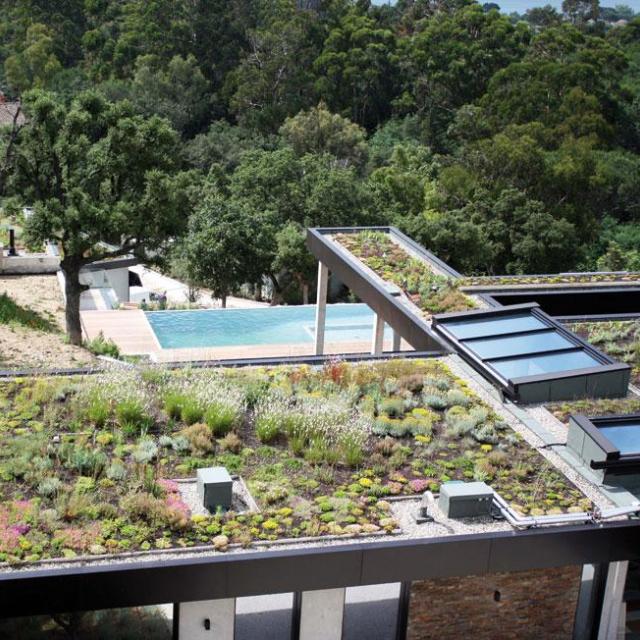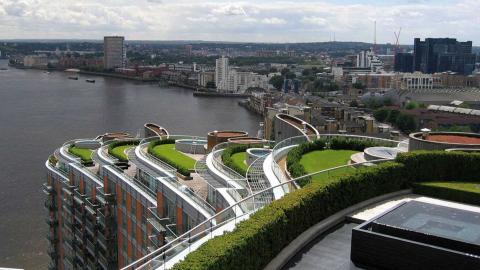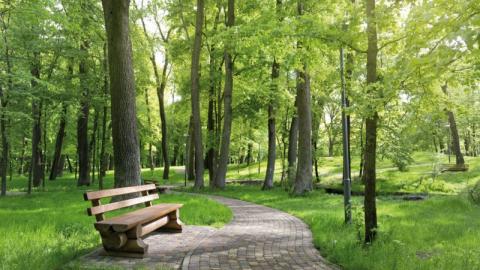Growing plants on roof-terraces goes back to ancient times, with the hanging gardens of Babylon. Today, the techniques have been mastered, and the applications more and more recognised and adopted. Just like in Germany, we would like to see the planting of greenery on buildings become more developed in France, for the good of everyone. State of the Art and perspectives.

Plants have been grown on the terrace roofs of building for around thirty years, but now more than ever, planting vegetation on buildings fulfils many varied functions in response to a number of key issues:
• protecting the building and increasing the life of the outer surfaces and cover materials (waterproofing, for example);
• participating in the everyday comfort of the buildings (sound and thermal proofing);
• contributes towards the everyday comfort of densely populated urban areas (reduction in the heat island effect through evapotranspiration, combatting pollution);
• contributes towards storm water management (prevents the saturation/clogging of the drainage networks through the temporary retention of water on the roof) in a natural and economic manner;
• contributes towards maintaining and developing biodiversity in an urban environment by using the green belt notion;
• contributes towards the city life, economically (for the people who only consume locally-produced food) or socially (by creating a connection) by embracing home garden vegetable production.
Once upon a time
The gardens of Babylon or other traditions growing plants on the roofs or walls were the pioneers. In the architecture of the 20th century, the garden terrace was progressively becoming one of the solutions for conserving an attachment with nature in the city. The technical components that make up this solution have been improved since the 1970s, with the arrival of lightweight water-proofing membranes that are resistant to root invasion as well as lightweight earthy blends.
During the 1980s, Germany was at the forefront of implementing a novel solution, known as “extensive green roofs”. It was the rapid awareness of the authorities (subsidies from the Länder or Federal States and the city councils, in particular) and the incorporation of an “environmental spirit” in German society that led to its remarkable success.
In France, the concept of extensive green roofs appeared in the early-1990s and speeded up in the early-2000s, allied to a better grasp of the technique and a desire to make it part of a sustainable development approach.
The green roof systems
A green roof system comprises all the equipment, materials and plants placed on the roof. On the base support deck (concrete, steel or wood), which must be able to support the expected loads, there is a waterproofing layer, resistant to root intrusion, essential for the long life of the whole assembly. A specific thermal insulation, generally placed under the waterproofing layer, completes this section. Traditionally, green roofs can be divided up into three major categories:
The keys to the success of a green roof-terrace
The architect or design engineer will carry out a study upstream to determine the feasibility of the project, particularly with regard to the admissible loads. A good understanding of the nature of the base support and the insulation-waterproofing layers is essential for the design of the green roof. The different components that constitute the growing medium (drainage, filtration, substrate, plant species and also irrigation) will be chosen according to the expectations and possibilities offered by the structure within its given environment (climate, exposure, slope of the roof, etc.).
With regard to extensive vegetation specifically, the profession, via the association Adivet (see insert), has set out the professional guidelines, publishing the 3rd edition in 2018, in order to fill the vacuum left by the lack of statutory rules and regulations and bring precise responses to the different cases encountered.
The key element for a perennial green roof: maintenance
The extensive and semi-intensive green roofs should function in the form of an ecosystem, which would reduce the maintenance required for the vegetation. However, this maintenance, albeit greatly reduced, is absolutely essential for maintaining control over the plant growth.
The aim of the maintenance is to obtain or conserve a level of plant cover greater than 80%, to control the build-up of weeds and ensure the sustainable development of the chosen vegetation. It consists generally of cleaning the rainwater intakes, removing the waste material blown in by the wind, putting back in place layers of vegetation displaced by the wind, manually picking out any undesirable plants, replanting non-vegetated areas and applying supplementary fertilisation as required after visually inspecting the site. In the specific case of the vegetation mainly consisting of grasses, then it will also be necessary to plan for mowing operations. For roofs equipped with an automatic irrigation system, then it will be necessary to provide for the maintenance of the system, an adjustment of the parameters and flushing out in the winter.
Whether or not to use automatic irrigation?
The professional guidelines state that there must be one water supply point on the green roof. Not all roofs require regular watering but this water supply point could be useful for one-off irrigations when the plants are becoming established or during periods of extreme heat.
Should we opt for a water supply point or a complete irrigation system?
The choice of whether or not to place an irrigation system on the roof depends on a number of factors and this should not be overlooked because once the system is installed, it is very difficult to go back.
The first factor relates to the type of vegetation selected:
• For extensive vegetation, irrigation is not compulsory above an imaginary line commonly accepted as running from Lyons to Bordeaux.
• For semi-intensive to intensive vegetation, it is considered that an irrigation system is obligatory.
The second factor relates to the slope or pitch of the roof: all roofs with a slope of more than 20% must be equipped with an automatic irrigation system. With gravity doing its job, if the roof does not have this system, there will be an increased risk of seeing the plants wither.
The third factor relates to the choice of plant and the expected aesthetic level (roof visible or not visible, pedestrian access or inaccessible). If we turn towards plants other than sedums, the water requirements are higher and it becomes essential to install an automatic irrigation system.
The last factor to be taken into account is, of course, the climate and the building’s exposure to the elements. Given the expected climatic events and changes in the weather, it is important not to underestimate this. In fact, a report issued by Météo-France predicts that between now and 2050, there will be “an average rise in temperature of between 0.6 and 1.3°C” as well as an “increase in the number of days of heat waves in the summer”, so it may now be worthwhile considering changing the plant selection and the relevance of installing an irrigation system.
What irrigation solutions to choose?
As with green spaces, green roofs can be irrigated in several ways, which depend on several factors, such as the shape and type of surface of the green roof, the height of the substrate, type of vegetation (pre-grown in containers, boxes, mats, a-clods…), flow rate and available pressure.
The three most common systems are:
• Sprinklers. Frequently used as an irrigation solution on the first green roofs, sprinkling now has a reduced share of the green roof irrigation market. Exposure to the wind in particular disperses the droplets and the uniformity levels are not the best. The water supply point on the roof must, furthermore, be of a sufficient dimension so as not have to increase excessively the number of networks. The rotary nozzles remain the most sensible solution for sprinkler irrigation. Sprinkling is also quite an economical solution.
• Drip irrigation. Above-ground or subsurface drip irrigation is the main solution used at the present time. It has the main advantage of requiring a very low flow rate per m² (e.g.: 14.4 L/m² with drip irrigation at 1.6L/h spaced at 33cm and installed every 30cm or 20.7L/m² for 2.3L/h drippers).
Drip irrigation tubing is generally laid out directly onto the vegetation which gradually hides the pipe. It is highly recommended to have a manifold for supplying the systems.
For a roof accessible to pedestrians or even when aesthetics play an important part, the drip irrigation system is still the most suitable.
• The irrigation mat. The matting comes in the form of quite large rolls. This is a drip irrigation system (classical drip tubes or drip tapes for use in agriculture) embedded in the non-woven fabric or felt matting. The water flows into the fabric and is transferred to the substrate by capillary action. The main advantage of this solution is the level of irrigation uniformity achieved with each application. Its main drawback is its cost and the difficulty in using on roofs which include a large number of sections projecting upwards.
Whatever the system chosen, the implementation of an irrigation system on a green roof requires the work to be meticulous and of optimum quality because thin substrates will not tolerate a badly designed or poorly installed irrigation system.
Good coordination, communicating with the other professionals working on a green roof are also factors that are conducive to the success of the project: the plumbers who will be connecting the water supply on the roof (how many times have we seen a PER 12 [cross-lined polyethylene] on a roof to supply a 300 m² green roof); the electricians, who will be wanting to install ducts for the solenoid valve cables; the waterproofers, if they are different from the plant professionals for this phase of the work…
And the programming?
For the programming, it is also important to make sound choices from the moment the project begins. Should a zone-based (remote) controller or a battery-operated controller be used?
One important question to be asked before choosing is: who will be managing the green roof? In fact, the choice could be to programme directly from the roof or install the controller at the foot of the building in an equipment room. In the first case, installation will be simple but maintenance more difficult and vice versa.
The battery-operated systems are simple to install but if the building has a number of roofs, there could be a large number of controllers and their adjustments could require a particularly long intervention. In this respect, the zone-based controller would be more suitable. We could even consider decoder control systems for more complex sites.
All of the web-enabled control systems nowadays allow the user to optimally adjust the irrigation run times on the basis of the weather conditions and thus limit water consumption.
In conclusion
Vegetation on buildings has, for several years, been shown to have economic, ecological and energy-saving benefits… A number of studies continue to be conducted worldwide: University of Quebec, Catholic University of Lille, University of Tokyo, and University of Madrid... The EFB (European Federation of Green Roof Associations) estimates that each citizen should benefit from a minimum of 5m² green roofing or living walls between now and 2030, which would be equivalent to a green surface area of around 1.82 billion m²!
As far as France is concerned, ADIVET estimates that there are 1.6 million m² of green roofing created each year and it tends to grow because of the adoption of new laws (the biodiversity law of 2016 which makes it compulsory to have vegetation or solar panels on all new commercial buildings of more than 1000 m²) or the implementation of local development plans by some authorities.
Irrigation, therefore, has a bright future ahead, providing that the projects are considered carefully and conducted in accordance with professional standards.
Adivet brings together the key players in the green roofs and façades sector: component and system manufacturers, building and landscape contractors, professional groups, project managers and building owners, training and research organizations, research and design departments… All of their actions over the past 10 years have contributed to an unprecedented rise in green roofs in France, with more than 10 million m² installed. Being a key industry voice in dealings with the public authorities and the main players in the building and landscape sector, ADIVET co-authored the French Professional Rules for green roofs and terraces and drafted the first recommendations for roof-top urban agriculture techniques.



